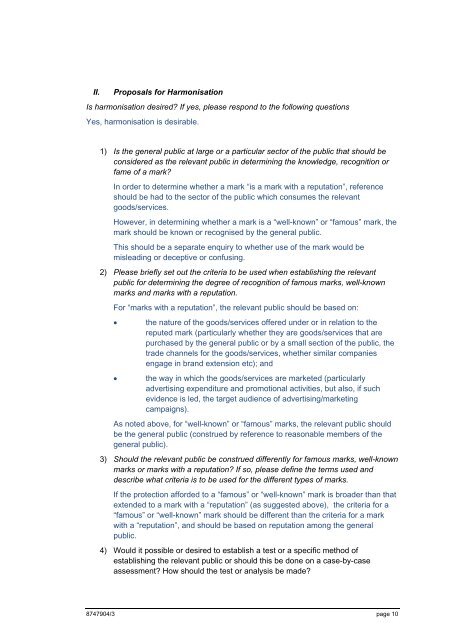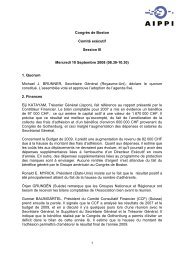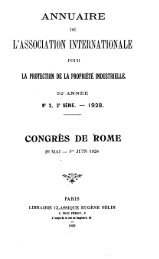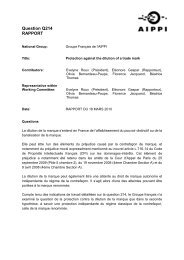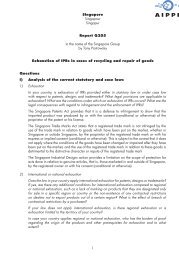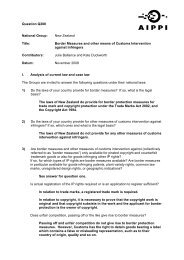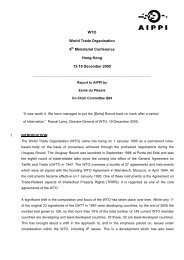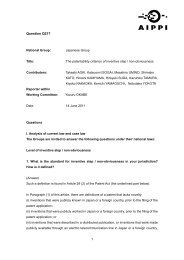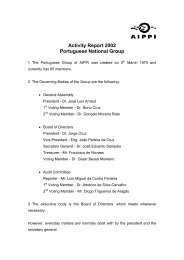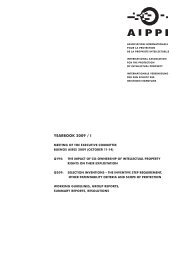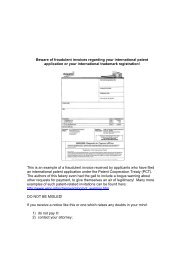Question Q234 National Group: Australia Title: Relevant ... - AIPPI
Question Q234 National Group: Australia Title: Relevant ... - AIPPI
Question Q234 National Group: Australia Title: Relevant ... - AIPPI
You also want an ePaper? Increase the reach of your titles
YUMPU automatically turns print PDFs into web optimized ePapers that Google loves.
II. Proposals for Harmonisation<br />
Is harmonisation desired? If yes, please respond to the following questions<br />
Yes, harmonisation is desirable.<br />
1) Is the general public at large or a particular sector of the public that should be<br />
considered as the relevant public in determining the knowledge, recognition or<br />
fame of a mark?<br />
In order to determine whether a mark “is a mark with a reputation”, reference<br />
should be had to the sector of the public which consumes the relevant<br />
goods/services.<br />
However, in determining whether a mark is a “well-known” or “famous” mark, the<br />
mark should be known or recognised by the general public.<br />
This should be a separate enquiry to whether use of the mark would be<br />
misleading or deceptive or confusing.<br />
2) Please briefly set out the criteria to be used when establishing the relevant<br />
public for determining the degree of recognition of famous marks, well-known<br />
marks and marks with a reputation.<br />
For “marks with a reputation”, the relevant public should be based on:<br />
<br />
<br />
the nature of the goods/services offered under or in relation to the<br />
reputed mark (particularly whether they are goods/services that are<br />
purchased by the general public or by a small section of the public, the<br />
trade channels for the goods/services, whether similar companies<br />
engage in brand extension etc); and<br />
the way in which the goods/services are marketed (particularly<br />
advertising expenditure and promotional activities, but also, if such<br />
evidence is led, the target audience of advertising/marketing<br />
campaigns).<br />
As noted above, for “well-known” or “famous” marks, the relevant public should<br />
be the general public (construed by reference to reasonable members of the<br />
general public).<br />
3) Should the relevant public be construed differently for famous marks, well-known<br />
marks or marks with a reputation? If so, please define the terms used and<br />
describe what criteria is to be used for the different types of marks.<br />
If the protection afforded to a “famous” or “well-known” mark is broader than that<br />
extended to a mark with a “reputation” (as suggested above), the criteria for a<br />
“famous” or “well-known” mark should be different than the criteria for a mark<br />
with a “reputation”, and should be based on reputation among the general<br />
public.<br />
4) Would it possible or desired to establish a test or a specific method of<br />
establishing the relevant public or should this be done on a case-by-case<br />
assessment? How should the test or analysis be made?<br />
8747904/3 page 10


